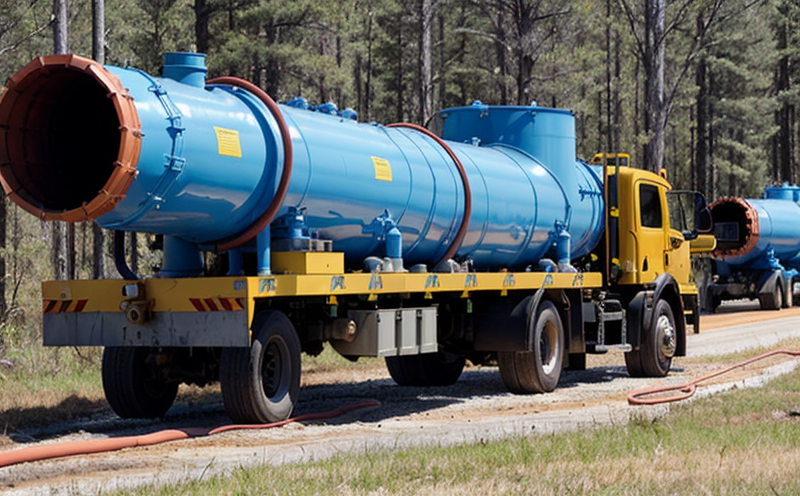ASTM D5504 Sulfur Compound Testing in Natural Gas
The ASTM D5504 standard provides a method for determining sulfur compounds in natural gas, which is critical for ensuring the safety and quality of this vital energy source. The presence of hydrogen sulfide (H2S) and other sulfur compounds can lead to corrosive damage, health hazards, and operational disruptions if not properly managed.
The testing outlined in ASTM D5504 is essential for compliance with regulations such as the American Gas Association's specifications and the Occupational Safety and Health Administration (OSHA). This method helps utilities meet these standards by accurately measuring sulfur compounds, which can then be mitigated through appropriate treatment processes.
Proper testing ensures that natural gas meets safety requirements, enhances operational efficiency, and protects both personnel and infrastructure. By identifying the presence of sulfur compounds early in the process, facilities can prevent costly downtime and ensure a safer working environment for all involved.
The ASTM D5504 method involves sampling natural gas from pipelines or storage tanks and analyzing it using an absorption-combustion detector (ACD). This technique allows for precise measurement of sulfur compounds, including mercaptans, thiols, and disulfides. The test results are reported in terms of the total sulfur content, typically measured as milligrams per cubic meter.
The importance of this testing cannot be overstated. Natural gas is a key component of many utility operations, and any deviation from safety standards can have serious consequences for both producers and consumers. By adhering to ASTM D5504, utilities can ensure that their natural gas meets all necessary regulatory requirements while also maintaining the highest level of quality.
Understanding the impact of sulfur compounds on infrastructure is crucial for effective management. Sulfur compounds can cause significant corrosion in pipelines and storage facilities, leading to costly repairs and potential leaks. By conducting regular ASTM D5504 tests, utilities can identify these issues early and take proactive measures to mitigate them.
The methodology described in ASTM D5504 is widely recognized as a reliable means of detecting sulfur compounds in natural gas. This ensures that the testing process is consistent across different facilities and regions, providing accurate results that can be trusted for decision-making purposes.
Why It Matters
The significance of ASTM D5504 sulfur compound testing in natural gas cannot be overstated. Properly conducted tests are essential to ensuring the safety and quality of this vital energy source. The presence of hydrogen sulfide (H2S) and other sulfur compounds can lead to corrosive damage, health hazards, and operational disruptions if not properly managed.
The ASTM D5504 method is particularly important for utilities that are responsible for distributing natural gas to end-users. By adhering to this standard, utilities can ensure that their products meet all necessary regulatory requirements while also maintaining the highest level of quality. This testing ensures that any sulfur compounds present in the natural gas are accurately measured and reported.
The importance of ASTM D5504 cannot be overstated for several reasons:
- It helps ensure compliance with regulations such as those set by the American Gas Association (AGA) and Occupational Safety and Health Administration (OSHA).
- It provides accurate measurements of sulfur compounds, which are critical for maintaining pipeline integrity.
- It enhances operational efficiency by identifying potential issues early in the process.
- It protects personnel and infrastructure from health hazards and costly repairs.
Scope and Methodology
| Sample Preparation | Treatment Process | Instrumentation | Data Reporting |
|---|---|---|---|
| Samples are collected from pipelines or storage tanks using appropriate sampling devices. | The samples undergo a series of treatments to remove moisture and other contaminants. | An absorption-combustion detector (ACD) is used for accurate measurement of sulfur compounds. | Results are reported in terms of total sulfur content, typically measured as milligrams per cubic meter. |
The ASTM D5504 standard specifies a detailed procedure for collecting and treating samples to ensure accurate testing results. Samples are collected from pipelines or storage tanks using appropriate sampling devices. The collected samples undergo a series of treatments designed to remove moisture and other contaminants that could interfere with the detection process.
Once the samples have been prepared, they are analyzed using an absorption-combustion detector (ACD). This instrument is specifically designed for detecting trace amounts of sulfur compounds in natural gas. The ACD works by first absorbing the sample into a solution and then combusting it to release any sulfur compounds present. These compounds are then detected and measured.
The results of this analysis provide an accurate measurement of the total sulfur content in the natural gas, typically reported as milligrams per cubic meter. This information is crucial for utilities to ensure that their products meet all necessary regulatory requirements while also maintaining the highest level of quality.
Quality and Reliability Assurance
The accuracy and reliability of ASTM D5504 sulfur compound testing are critical factors in ensuring the safety and quality of natural gas. To maintain these standards, laboratories must adhere to strict quality management systems (QMS) that include regular calibration and validation of instruments.
Regular audits by independent third parties help ensure compliance with industry standards and best practices. These audits also provide feedback on areas for improvement, ensuring continuous quality enhancement. By maintaining high-quality testing processes, laboratories can build trust among clients and stakeholders.
In addition to internal controls, external certifications play a vital role in establishing credibility. Laboratories should seek accreditation from recognized bodies such as the American Society for Testing and Materials (ASTM) or similar organizations. This accreditation demonstrates commitment to excellence and helps establish confidence in test results.
Continuous training of staff is another key factor in maintaining consistent quality standards. Regular workshops and seminars ensure that employees stay updated on new developments in testing methodologies and technology. By investing in ongoing education, laboratories can provide accurate and reliable services consistently.





